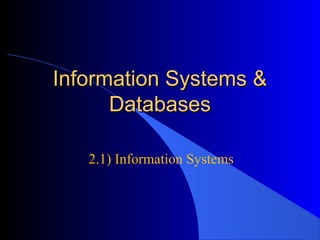
12 ipt 0201 information systems
- 1. Information Systems & Databases 2.1) Information Systems
- 2. • Information systems are created to provide access to information for an organisation or individual. • They perform a set of information processes involving participants, data/information and information technology. • In a large number of information systems, the data is held in a database and accessed through a database management system (DBMS).
- 3. • The characteristics of an information system are: • organisation of data into information – careful thought is required to sort and link large amounts of data (e.g. data dictionary) • analysis of data to give knowledge – analysed data should be output into useful forms, such as tables, charts, queries and forms.
- 4. • There are many different types of information systems, including: • transaction processing systems • decision support systems • expert systems • management information systems • office automation systems • Transaction processing systems (TPS’s) deal with the daily transactions of an organisation.
- 5. • This could include buying and selling of goods and services, banking, shares and point-of-sale (POS) transactions. • Organisations rely heavily upon their TPS, a breakdown will disrupt operations, so they must be well designed with solid backup and recovery procedures. • TPS’s use both real-time and batch processing, depending upon their circumstances.
- 6. • Decision support systems (DSS’s) assist people by providing information, models and analysis tools. • E.g. stockmarket analysis software • A DSS creates a mathematical model utilising the variables of the situation and then uses various tools to answer ‘what-if’ questions. • These tools could include statistical tools, databases, spreadsheets and graphics.
- 7. • The reliability of the DSS depends upon the accuracy of the model and the manager’s ability to formulate good questions. • An expert system is a special kind of DSS. • They are used to provide information and solve problems that would otherwise require a person experienced in that field.
- 8. • They are useful in diagnosing, monitoring, selecting, designing, predicting and training. • An expert system asks a series of questions and compares the answers to a knowledge base. • A knowledge base is a set of facts and ‘if-then’ rules supplied by an expert or team of experts. • E.g. online medical diagnosis.
- 9. • The answers provided by an expert system are sometimes incorrect, since the logic of the knowledge base is not always followed. • Management information systems (MIS’s) provide information for the organisation’s managers. • An MIS provides an overview as to how the organisation is faring. • E.g. reports on sales, inventory, payroll, orders and budgets.
- 10. • Office automation systems provide a means to completing routine administrative tasks. • They use a range of tools including word processing, databases, spreadsheets, desktop publishing (DTP), presentation programs and project management software. • They also utilise communications technology such as web browsers, email, instant messaging and telepresence systems.
- 11. • Regularly published newsletters and memos are both examples of this kind of system in action. • Another suitable example is quickly producing large numbers of letters and documents through a mail-merge process. • Most of these different kinds of information systems use a database. • Databases are accessed through a software package known as a database management system (DBMS).
- 12. • A DBMS has no data in it, but rather accesses and manipulates the data found within a database file. • A database is an organised collection of data that can be sorted and searched for information. [Read MovieTime case study (p.39) and then answer Exercise Q.9]